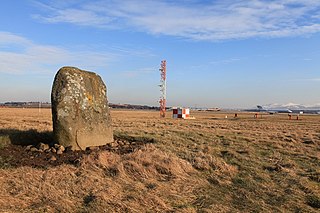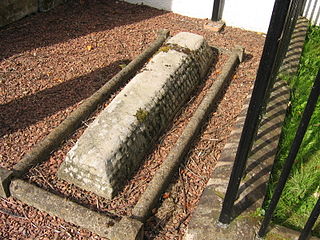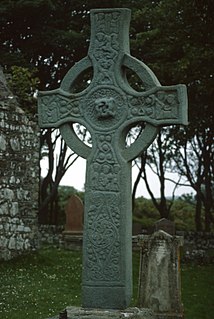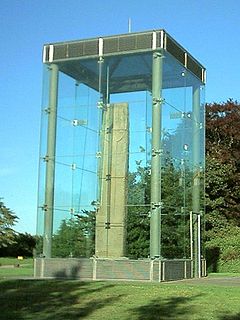 W
WThe architecture of Scotland in the Middle Ages includes all building within the modern borders of Scotland, between the departure of the Romans from Northern Britain in the early fifth century and the adoption of the Renaissance in the early sixteenth century, and includes vernacular, ecclesiastical, royal, aristocratic and military constructions. The first surviving houses in Scotland go back 9500 years. There is evidence of different forms of stone and wooden houses exist and earthwork hill forts from the Iron Age. The arrival of the Romans led to the abandonment of many of these forts. After the departure of the Romans in the fifth century, there is evidence of the building of a series of smaller "nucleated" constructions sometimes utilizing major geographical features, as at Dunadd and Dumbarton. In the following centuries new forms of construction emerged throughout Scotland that would come to define the landscape.
 W
WArt in Medieval Scotland includes all forms of artistic production within the modern borders of Scotland, between the fifth century and the adoption of the Renaissance in the early sixteenth century. In the early Middle Ages, there were distinct material cultures evident in the different federations and kingdoms within what is now Scotland. Pictish art was the only uniquely Scottish Medieval style; it can be seen in the extensive survival of carved stones, particularly in the north and east of the country, which hold a variety of recurring images and patterns. It can also be seen in elaborate metal work that largely survives in buried hoards. Irish-Scots art from the kingdom of Dál Riata suggests that it was one of the places, as a crossroads between cultures, where the Insular style developed.
 W
WIn Celtic cultures, a bard is a professional story teller, verse-maker, music composer, oral historian and genealogist, employed by a patron to commemorate one or more of the patron's ancestors and to praise the patron's own activities.
 W
WThe Cat Stane, or Catstane, is an inscribed standing stone near Kirkliston, on the outskirts of Edinburgh, in Scotland. It bears a fragmentary inscription dating to the fifth or sixth centuries and was part of a funerary complex consisting of the stone itself, a cairn and a series of cist burials.
 W
WThe Cat Stones of Scotland are natural prominent rock features or standing stones around Scotland that are often linked to battles or burials. The English term cat applied to such stones derives from the Gaelic cath. Clach a'Chait would be the Gaelic for "Stone of the Cat".
 W
WThe Celtic harp is a triangular frame harp traditional to Ireland, Wales, and Scotland. It is known as cláirseach in Irish and clàrsach in Scottish Gaelic. In Ireland and Scotland, it was a wire-strung instrument requiring great skill and long practice to play, and was associated with the Gaelic ruling class. It appears on Irish and British coins, the coat of arms of the Republic of Ireland, Montserrat, the United Kingdom and Canada as well as the flag of Montserrat.
 W
WCourt music in Scotland is all music associated with the Royal Court of Scotland, between its origins in the tenth century, until its effective dissolution in the seventeenth and eighteenth centuries with the Union of Crowns 1603 and Acts of Union 1707.
 W
WThe Dunkeld Lectern is a mediaeval lectern which was one of the most prized possessions of St Stephen's Church, St Albans, England. The 150 kg brass reading desk stands approximately 1.6 metres high and takes the form of a large eagle with outspread wings, with the bird perched on an orb supported by a turned shaft: an eagle lectern. Engraved on the orb is a Latin inscription Georgius Creichton Episcopus Dunkeldensis.
 W
WThe Dupplin Cross is a carved, monumental Pictish stone, which dates from around 800 AD. It was first recorded by Thomas Pennant in 1769, on a hillside in Strathearn, a little to the north Forteviot and Dunning. In 2002 it was placed in the care of Historic Scotland, and was placed for preservation under the 11th/12th century tower of St Serf's Church in Dunning. Open to the public April-September.
 W
WCulture of Scotland in the High Middle Ages refers to the forms of cultural expression that come from Scotland in the High Medieval period which, for the purposes of this article, refers to the period between the death of Domnall II in 900, and the death of Alexander III in 1286. The unity of the period is suggested by the immense breaks which occur in Scottish history because of the Wars of Scottish Independence, the Stewart accession and transformations which occur in Scottish society in the fourteenth century and afterwards. The period differentiates itself because of the predominance of Gaelic culture, and, later in the medieval, Scoto-Norman French culture.
 W
WHogbacks are stone carved Anglo-Scandinavian sculptures from 10th- to 12th-century England and Scotland. Singular hogbacks were found in Ireland and Wales. Hogbacks fell out of fashion by the beginning of the 11th century. Their function is generally accepted as grave markers. Similar grave markers have been found in Scandinavia.
 W
WInsular art, also known as Hiberno-Saxon art, was produced in the post-Roman era of the British Isles. The term derives from insula, the Latin term for "island"; in this period Britain and Ireland shared a largely common style different from that of the rest of Europe. Art historians usually group insular art as part of the Migration Period art movement as well as Early Medieval Western art, and it is the combination of these two traditions that gives the style its special character.
 W
WInsular script was a medieval script system originating from Ireland that spread to Anglo-Saxon England and continental Europe under the influence of Irish Christianity. Irish missionaries took the script to continental Europe, where they founded monasteries such as Bobbio. The scripts were also used in monasteries like Fulda, which were influenced by English missionaries. They are associated with insular art, of which most surviving examples are illuminated manuscripts. It greatly influenced Irish orthography and modern Gaelic scripts in handwriting and typefaces.
 W
WThe Kildalton Cross is a monolithic high cross in Celtic cross form in the churchyard of the former parish church of Kildalton (from Scottish Gaelic Cill Daltain, "Church of the Foster Son" on the island of Islay in the Inner Hebrides, Scotland. It was carved probably in the second half of the 8th century AD, and is closely related to crosses of similar date on Iona. It is often considered the finest surviving Celtic cross in Scotland, and is certainly one of the most perfect monuments of its date to survive in western Europe. The cross and the adjacent roofless medieval parish church are in the care of Historic Environment Scotland and are jointly a scheduled ancient monument. A simpler cross of late medieval date stands nearby.
 W
WThe Lamont Harp, or Clàrsach Lumanach is a Scottish Clarsach currently displayed in the National Museum of Scotland. It is believed to date back to the 15th century, and to have originated in Argyll. Along with the Queen Mary Harp and the Trinity College harp, it is one of the only three surviving medieval Gaelic harps.
 W
WThe Lang Stane of Auquhollie is an Ogam-inscribed standing stone some 6 kilometres north-west of Stonehaven in Scotland. Situated on south side of Meikle Carew Hill at a height of about 140 metres above sea level, the stone is approximately 3 metres in height and 0.75 metres in diameter, an unshaped monolith of gneiss.
 W
WThe Monymusk Reliquary is an eighth century Scottish house-shaped reliquary made of wood and metal characterised by an Insular fusion of Gaelic and Pictish design and Anglo-Saxon metalworking, probably by Ionan monks. It is now in the National Museum of Scotland in Edinburgh.
 W
WMusic in Medieval Scotland includes all forms of musical production in what is now Scotland between the fifth century and the adoption of the Renaissance in the early sixteenth century. The sources for Scottish Medieval music are extremely limited. There are no major musical manuscripts for Scotland from before the twelfth century. There are occasional indications that there was a flourishing musical culture. Instruments included the cithara, tympanum, and chorus. Visual representations and written sources demonstrate the existence of harps in the Early Middle Ages and bagpipes and pipe organs in the Late Middle Ages. As in Ireland, there were probably filidh in Scotland, who acted as poets, musicians and historians. After this "de-gallicisation" of the Scottish court in the twelfth century, a less highly regarded order of bards took over the functions of the filidh and they would continue to act in a similar role in the Scottish Highlands and Islands into the eighteenth century.
 W
WThe origins of the triangular frame harp are unclear. Triangular objects on the laps of seated figures appear in artwork of the Ireland, Scotland, England and Wales, as well as other parts of north-west Europe. This page outlines some of the scholarly controversies and disagreements on this subject.
 W
WSueno's Stone is a Picto-Scottish Class III standing stone on the north-easterly edge of Forres in Moray and is the largest surviving Pictish style cross-slab stone of its type in Scotland, standing 6.5 metres in height. It is situated on a raised bank on a now isolated section of the former road to Findhorn. The stone is named after Sweyn Forkbeard, but this association has been challenged and it has also been associated with the killing of King Dubh mac Ailpin in Forres in 966. The stone was erected c. 850–950 but by whom and for what, is unknown.